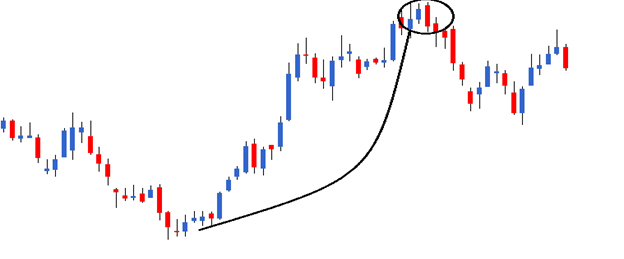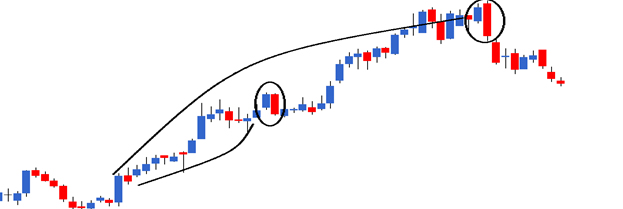The bearish engulfing pattern is a two candlestick pattern which appears at the top end of the trend, thus making it a bearish pattern. The thought process remains very similar to the bullish engulfing pattern, except one has to think about it from a shorting perspective.
Take a look at the chart below, the two candles that make up the bearish engulfing pattern is encircled. You will notice:

- To begin with the bulls are in absolute control pushing the prices higher
- On P1, as expected the market moves up and makes a new high, reconfirming a bullish trend in the market
- On P2, as expected the market opens higher and attempts to make a new high. However at this high point selling pressure starts. This selling comes unexpected and hence tends to displace the bulls
- The sellers push the prices lower, so much so that the stock closes below the previous day’s (P1) open. This creates nervousness amongst the bulls
- The strong sell on P2 indicates that the bears may have successfully broken down the bull’s stronghold and the market may continue to witness selling pressure over the next few days
- The idea is to short the index or the stock in order to capitalize on the expected downward slide in prices
The trade set up would be as follows:
- The bearish engulfing pattern suggests a short trade
- The risk taker initiates the trade on the same day after validating two conditions
- The open on P2 is higher than P1’s close
- The current market price at 3:20 PM on P2 is lower than P1’s open price. If the two conditions are satisfied, then it would be logical to conclude that it is a bearish engulfing pattern
- The risk averse will initiate the trade on the day after P2 only after ensuring that the day is a red candle day
- Since the bearish engulfing pattern is a 2 day pattern, it makes sense to be a risk taker. However this purely depends on the individual’s risk appetite
Take a look at the chart below of Ambuja Cements. There are two bearish engulfing patterns formed. The first pattern on the chart (encircled, starting from left) did not work in favor of a risk taker. However the risk averse would have completely avoided taking the trade. The second bearish engulfing pattern would have been profitable for both the risk taker and the risk averse.

The OHLC data for the bearing engulfing pattern (encircled at the top end of the chart) is as below:
P1: Open – 214, High – 220, Low – 213.3, Close – 218.75
P2: Open – 220, High – 221, Low – 207.3, Close – 209.4
The trade setup for the short trade, based on the bearish engulfing pattern is as follows:
- On P2 by 3:20 PM the risk taker would initiate the short trade at 209 after ensuring P1, and P2 together form a bearish engulfing pattern
- The risk averse will initiate the trade, the day after P2 only after ensuring that the day is a red candle day
- The stoploss in both the cases will the highest high of P1 and P2, which in this case is at 221.
Both the risk averse and the risk taker would have been profitable in this particular case.



0 Comments